Major Scale Harmony and Musical Modes on the Guitar
Understanding music theory can significantly enhance your guitar playing skills and overall musicality. Among the foundational concepts in music theory are major scale harmony and musical modes, both of which play crucial roles in crafting melodies, harmonies, and chord progressions.
Major Scale Harmony
The major scale is a fundamental concept in Western music theory. It’s constructed from a specific sequence of whole steps (W) and half steps (H).
The formula for the major scale is:
W – W – H – W – W – W – H
In the key of C major, the notes of the scale are:
C – D – E – F – G – A – B – C
In terms of harmony, the major scale provides the foundation for chords and chord progressions. The chords built from the major scale are typically referred to using Roman numerals.
Here’s how chords are derived from the major scale:
- Major (I): Built on the 1st degree, it’s a major chord
- Minor (ii): Built on the 2nd degree, it’s a minor chord
- Minor (iii): Built on the 3rd degree, it’s a minor chord
- Major (IV): Built on the 4th degree, it’s a major chord
- Major (V): Built on the 5th degree, it’s a major chord
- Minor (vi): Built on the 6th degree, it’s a minor chord
- Diminished (vii°): Built on the 7th degree, it’s a diminished chord
In C major, the basic triad chords would be:
Cmaj, Dmin, Emin, Fmaj, Gmaj, Amin, Bdim
It’s no accident that these chords correspond with the notation used in the Nashville Number System.
What Are the Musical Modes and Why Should You Learn Them?
Modes are like the diverse flavors in a spice rack, each offering a unique taste to your musical palette. Derived from the major scale, modes highlight the distinct sound of specific chords, making your melodies and solos more intentional and flavorful.
Understanding the modes will expand your musical horizons and enhance your improvisational skills, making your guitar playing more dynamic and expressive.
The 7 Musical Modes
Modes are scales derived from the major scale, each with unique intervals and tonal characteristics.
Unlike the pentatonic scale, there are seven diatonic modes on the guitar, each originating from a degree of the Ionian mode, also known as the major scale.
By starting the major scale on different degrees, we generate seven distinct modes:
- Ionian: This is the major scale. It starts on the 1st degree of the major scale.
- Dorian: Starts on the 2nd degree of the major scale.
- Phrygian: Starts on the 3rd degree of the major scale.
- Lydian: Starts on the 4th degree of the major scale.
- Mixolydian: Starts on the 5th degree of the major scale.
- Aeolian: This is the natural minor scale. It starts on the 6th degree of the major scale.
- Locrian: Starts on the 7th degree of the major scale.
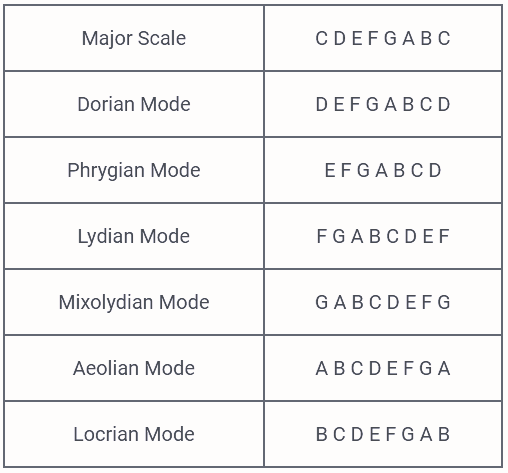
Each mode has a unique set of intervals, giving it a distinct sound. For example, the Dorian mode has a minor 3rd and a major 6th, providing a somewhat mysterious and jazzy sound.
You can learn to play these scales and chords on the guitar by memorizing their patterns and shapes on the fretboard. Each mode will have its unique pattern starting from different positions on the fretboard.
Understanding major scale harmony and modes is essential for composing, improvising, and understanding the underlying structure of a wide range of music. Practice playing these scales and chords regularly to internalize their sounds and shapes on the guitar.
1. Ionian Mode (the Major Scale)

Also known as the major scale, the Ionian mode has a bright, uplifting character. Its sound is often associated with feelings of happiness, optimism, and celebration, making it a popular choice for creating cheerful melodies and harmonies.
- Intervals: 1 – 2 – 3 – 4 – 5 – 6 – 7
- Flavor: Bright, cheerful
- Practice Tip: Play over a Cmaj7 chord, focusing on the suspenseful resolution from the 7th to the root.
2. Dorian Mode

The Dorian mode has a soulful, jazzy vibe characterized by its minor 3rd and major 6th intervals. It evokes a sense of mystery and longing, lending itself well to bluesy improvisations and melancholic melodies.
- Intervals: 1 – 2 – b3 – 4 – 5 – 6 – b7
- Flavor: Soulful, melancholic
- Practice Tip: Explore its compatibility with a Cm6 chord for a jazzy feel
3. Phrygian Mode
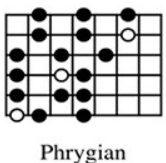
With its distinctive minor 2nd interval, the Phrygian mode has an exotic, Spanish-flavored sound. It carries a sense of tension and drama, often used to evoke feelings of passion, intensity, and yearning.
- Intervals: 1 – b2 – b3 – 4 – 5 – b6 – b7
- Flavor: Mysterious, exotic
- Practice Tip: Delve into its tension-filled sound, commonly heard in flamenco or metal genres
4. Lydian Mode
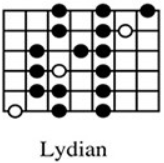
The Lydian mode features a raised 4th degree, giving it a dreamy, ethereal quality. Its sound is often described as airy and otherworldly, making it perfect for creating atmospheric and introspective music.
- Intervals: 1 – 2 – 3 – #4 – 5 – 6 – 7
- Flavor: Dreamy, magical
- Practice Tip: Experiment with Cmaj7#11 for a true Lydian vibe
5. Mixolydian Mode

The Mixolydian mode has a bluesy, rock ‘n’ roll feel due to its dominant 7th interval. It exudes a sense of freedom and rebellion, making it a favorite choice for creating energetic and groove-oriented music.
- Intervals: 1 – 2 – 3 – 4 – 5 – 6 – b7
- Flavor: Funky, bluesy
- Practice Tip: Try it over a C13 chord for its characteristic sound
6. Aeolian Mode (the Natural Minor Scale)
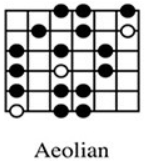
Also known as the natural minor scale, the Aeolian mode has a dark, introspective character. Its sound is often associated with sadness, longing, and introspection, making it ideal for expressing deep emotions and melancholy themes.
- Intervals: 1 – 2 – b3 – 4 – 5 – b6 – b7
- Flavor: Dark, sorrowful
- Practice Tip: Experiment with a Cm9 chord to capture its essence
7. Locrian Mode
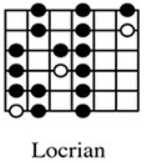
The Locrian mode is the darkest and most dissonant of all the modes, featuring a diminished 5th and diminished 7th interval. Its sound is tense, unstable, and unsettling, evoking feelings of unease and suspense, often used sparingly in experimental and avant-garde music.
- Intervals: 1 – b2 – b3 – 4 – b5 – b6 – b7
- Flavor: Unsettled, dissonant
- Practice Tip: Challenge yourself with a Cm7b5 chord and embrace the mode’s unique character
Applying Major Scale Harmony and Modes on Guitar
Guitarists can bring major scale harmony and modes to life by learning their patterns and shapes on the fretboard. By memorizing these patterns, players can effortlessly navigate scales and chords, unlocking endless possibilities for creativity and expression.
For example, to play the C major scale on the guitar, one might start with the open C string and ascend through the familiar pattern of whole and half steps, eventually reaching the octave C on the 20th fret of the high E string.
Similarly, chords derived from the major scale can be played using various chord shapes and voicings along the fretboard, allowing for smooth transitions between different harmonic textures.
When exploring modes, guitarists can experiment with shifting the starting position of the major scale pattern to correspond with each mode’s unique degree.
By doing so, they can immerse themselves in each mode’s distinct sounds and moods, from Ionian’s uplifting brightness to Dorian’s haunting allure and beyond.
Memorizing Modes Made Simple
To further solidify your grasp on modes, let’s adopt a systematic approach to memorization. By following the whole-step/half-step pattern of the major scale, you can effortlessly unlock the secrets of all modes, regardless of the root note. Here’s how:
Understand the Major Scale Blueprint
Begin by familiarizing yourself with the structure of the major scale, which follows a specific pattern of whole steps (W) and half steps (H). For instance, all major scales follow the sequence: W – W – H – W – W – W – H.
Apply the Pattern to Different Root Notes
Apply it to different root notes once you’re comfortable with the major scale pattern. Start from any note on the fretboard and follow the sequence of whole steps and half steps to construct the corresponding major scale. For example, starting from D, you would follow the pattern:
- D – E (W)
- E – F# (W)
- F# – G (H)
- G – A (W)
- A – B (W)
- B – C# (W)
- C# – D (H)
…resulting in the D major scale.
Recognize Mode Relationships
Every mode follows the same whole-step/half-step pattern as its parent major scale. By understanding this relationship, you can easily derive the modes from any major scale. For instance, the D Dorian mode shares the same notes as the C major scale but starts and ends on D.
Practice Transposing
To solidify your understanding, practice transposing modes to different keys. Start with simple exercises, such as shifting a mode up or down by one fret, and gradually increase the complexity. This process reinforces your knowledge of intervals and enhances your fretboard awareness.
Utilize Visual Aids
Utilize fretboard diagrams, scale charts, or interactive apps to visualize and reinforce mode patterns across the fretboard. These visual aids visually represent scale shapes and facilitate quicker memorization.
By systematically applying these steps, navigating through modes becomes intuitive and second nature. Remember, consistency and practice are key to mastering modes on the guitar. Keep exploring, experimenting, and challenging yourself to unlock the full potential of these versatile musical tools.
The Coda
In conclusion, major scale harmony and musical modes are essential for any guitarist looking to deepen their understanding of music theory and expand their creative horizons.
By mastering these concepts, guitarists gain the tools to compose captivating melodies, craft compelling chord progressions, and improvise confidently.
Through diligent practice and exploration, guitarists can unlock the full potential of major scale harmony and modes, transforming them from theoretical concepts into powerful tools for musical expression.
Ready to unlock the secrets of guitar modes? Contact Green Hills Guitar Studio today to book private guitar lessons in Nashville or online.






